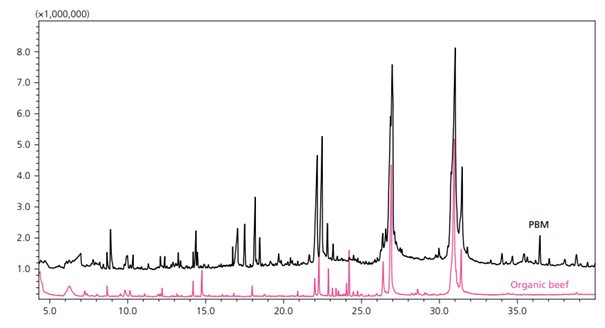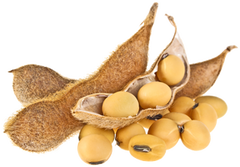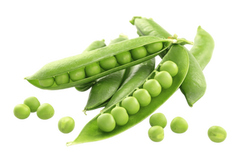Panel discussion on...
Alternative proteins
Welcome in the world of alternative meat: analytical challenges and perspectives
Introduction
As a manufacturer of analytical instrumentation Shimadzu is deeply involved in the development of applications for achieving the highest level of food safety standards. This is one important goal and requires the state of the art system configurations with high sensitivity in order to detect low levels of contaminants such as pesticides, mycotoxins, heavy metals, PFAS and many more in traditional food such as fruit, vegetables, milk and meat as well as drinking water.
The world population is steadily growing and by 2030 it is expected to be 8.5 billion people, which requires the production of food to be doubled. The use of fertilizers and pesticides must be optimized. Many farmers use pesticides to protect crops from environmental pests such as weeds, insects, and fungi. These chemical and biological agents improve cultivation, but toxic pesticide residues can remain in the crops, even after harvesting. Therefore, it is so important to test food products to ensure their safety for human consumption. Did you know that every year 600 Million fall ill and 480 Thousand die by contaminated food? (1).
The EU Commission has proposed new rules to reduce the use and risk of pesticides in the EU until 2030 (2). They have fixed legally binding targets to reduce pesticides by 50% and the member states have to set strategies to achieve the EU target collectively. This strategy is supported by European reference laboratories (EURL). The EURL for fruit and vegetables is located in Almeria, Spain and developing methods for pesticide testing, based on an SFC-LC-triple quadrupole mass spectrometer, which is using CO2 instead of organic solvents and is regarded as a green analytical method.
Global meat consumption has increased 5-fold over the past 50 years and shows no sign of decreasing. It has also been reported that livestock products account for approximately 20 % of global greenhouse gas emissions, and that livestock products cause soil and water pollution (3). In recent years, “meat alternatives” that artificially reproduces the texture, flavor, and appearance of meat has been developed. There are two types of meat alternatives: “plant-based meat (PBM),” which is made mainly from vegetable proteins such as soybeans, peas and mushrooms, and “cultured meat,” which is made by culturing stem cells from animals such as cattle.
Both are attracting growing interest in food markets around the world.
What is required to scale-up production of alternative protein sources, such as lab-grown meat and cultivated (breast/bovine) milk?
For the production of 1 kg meat approx. 1 thousand times more water is needed than for 1 kg grain. And furthermore 60% of grain production in Germany is used for feeding cattle and pork.
The development of automated production equipment for tailor-made cultured meat using 3D bioprinting will help to feed the world (4).
The 3D bioprinting technology was developed by Professor Matsusaki of the Osaka University to create muscle tissue structures. This technology is expected to be utilized in the field of food, for production of cultured meat with controlled arrangement of muscle, fat, and blood vessels.
Most of the cultured meats reported so far have a minced structure consisting only of muscle cells, making it difficult to reproduce complex structures. To solve this problem, Matsusaki and co-workers developed a 3D bioprinting technology that uses 3D printing to produce different fibrous tissues (muscle, fat, and blood vessels) and integrates them into a bundle. This technology has made it possible not only to reproduce the famous Wagyu beef, but also to delicately adjust the fat and muscle components. Osaka University and Shimadzu will jointly develop equipment to automate the production of cultured meat using this technology. (5).
What are the most effective methods for enhancing the flavor and texture of alternative proteins?There are meaningful reasons not to go for these new types of foods
Bad experience in terms of taste and texture
Raw meat on its own has little aroma; therefore, almost all aromas associated with “meatiness” are created during the cooking process by the Maillard Reaction between amino acids and reducing sugars. That reaction determines which non-volatile precursors release volatile aroma compounds. Plant-based meat (PBM), products created to resemble animal meat in both look and taste, are growing in popularity. A plant protein such as soy protein concentrate, along with colors, stabilizers, and oils, is used to successfully mimic meat flavor and texture. And, just like in animal meat, the amino acids of that protein undergo the Maillard Reaction.
Samples of PBM were run with the solid phase microextraction GC-MS and the volatile profile was compared against that of the organic beef. Similar compounds, such as fatty acids and Maillard browning reaction products, were found in both types of meat (Figure 1).
The differences can be explained by the different and wide variety of precursors present in PBM since it contains amino acids and sugars from various sources as opposed to regular meat.
There are five basic tastes, including deliciousness, which are perceived by people. The amount and kind of amino acids contribute to taste components. Of all the amino acids, glutamic acid is widely known as a component of the delicious taste. Further, the types and component ratios of amino acids largely control the flavor of food products. For example, glycine and alanine are associated with sweetness, valine and leucine with bitterness, and aspartic acid and glutamic acid with deliciousness.
The texture of food, including the sense of crispness, springiness, firmness, and the feeling on the tongue, is an important element that together with taste has an impact on the deliciousness of food. Food texture is normally evaluated using sensory tests. However, sensory tests are often difficult to reproduce, due to individual differences in people’s sensations and physical condition.
A texture analyzer can support sensory test with objective results in the form of numerical values for use in the field of food development. The texture analyzer evaluates the texture characteristics and allows a comparison of the texture of plant-based meat (PBM) and, for instance, chicken meatballs. Compared to chicken-derived products, plant-based meatballs had a higher force under loading conditions with less elasticity, which is the property to restore deformation (6). It is consistent with the result of the sensory test.

Figure 1. Overlaid Representative Chromatograms for PBM (black) and Organic Beef (pink) (6).
Panelists
References and notes
- World Health Organization WHO, Food Safety key facts, Dec. 2022
- European Commission, EU toolbox of good practices, Feb. 2023
- https://www.shimadzu.com.au/industries/carbon-neutrality/food-agriculture/index.html
- Nature research, Cultivating gourmet meat in the lab, 2023
- https://www.eurekalert.org/news-releases/949329
- Evaluation of the Deliciousness of Meat Alternatives, Shimadzu Corporation, 2023



















